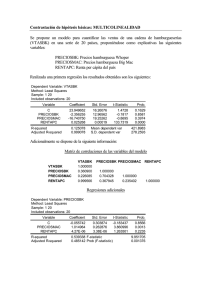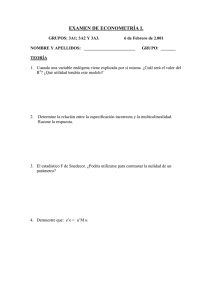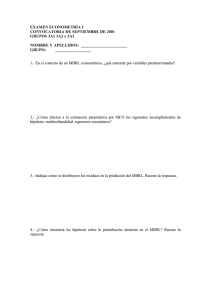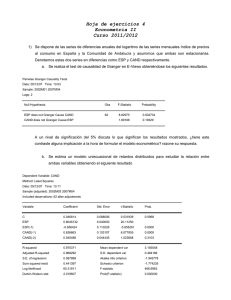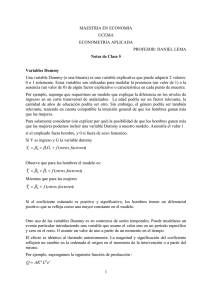Examen de Econometría II Licenciatura de Administración y
Anuncio
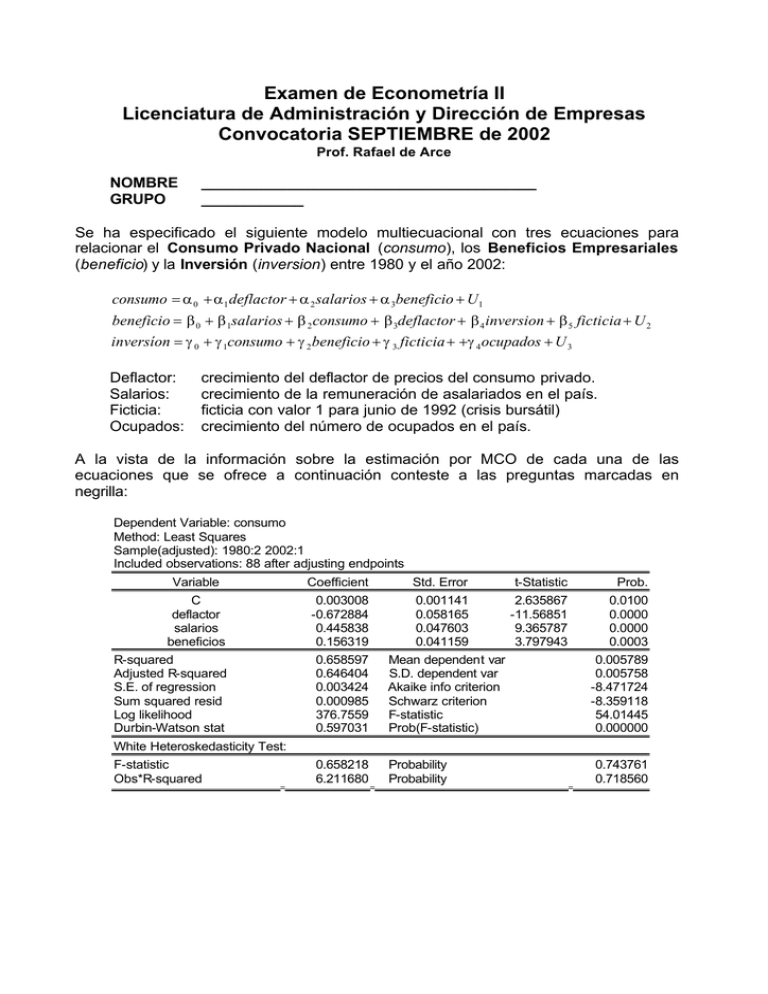
Examen de Econometría II Licenciatura de Administración y Dirección de Empresas Convocatoria SEPTIEMBRE de 2002 Prof. Rafael de Arce NOMBRE GRUPO _______________________________________ ____________ Se ha especificado el siguiente modelo multiecuacional con tres ecuaciones para relacionar el Consumo Privado Nacional (consumo), los Beneficios Empresariales (beneficio) y la Inversión (inversion) entre 1980 y el año 2002: consumo = α 0 + α1 deflactor + α 2 salarios + α 3beneficio + U1 beneficio = β 0 + β 1salarios + β 2 consumo + β 3deflactor + β 4 inversion + β 5 ficticia + U 2 inversíon = γ 0 + γ 1consumo + γ 2 beneficio + γ 3 ficticia + +γ 4 ocupados + U 3 Deflactor: Salarios: Ficticia: Ocupados: crecimiento del deflactor de precios del consumo privado. crecimiento de la remuneración de asalariados en el país. ficticia con valor 1 para junio de 1992 (crisis bursátil) crecimiento del número de ocupados en el país. A la vista de la información sobre la estimación por MCO de cada una de las ecuaciones que se ofrece a continuación conteste a las preguntas marcadas en negrilla: Dependent Variable: consumo Method: Least Squares Sample(adjusted): 1980:2 2002:1 Included observations: 88 after adjusting endpoints Variable Coefficient Std. Error t-Statistic Prob. C deflactor salarios beneficios 0.003008 -0.672884 0.445838 0.156319 0.001141 0.058165 0.047603 0.041159 2.635867 -11.56851 9.365787 3.797943 0.0100 0.0000 0.0000 0.0003 R-squared Adjusted R-squared S.E. of regression Sum squared resid Log likelihood Durbin-Watson stat 0.658597 0.646404 0.003424 0.000985 376.7559 0.597031 Mean dependent var S.D. dependent var Akaike info criterion Schwarz criterion F-statistic Prob(F-statistic) 0.658218 6.211680 Probability Probability 0.005789 0.005758 -8.471724 -8.359118 54.01445 0.000000 White Heteroskedasticity Test: F-statistic Obs*R-squared 0.743761 0.718560 Dependent Variable: beneficios Method: Least Squares Sample(adjusted): 1980:2 2002:2 Included observations: 88 after adjusting endpoints Variable Coefficient Std. Error t-Statistic Prob. C salarios consumo deflactor inversion FICTICIA 0.010997 -0.602825 0.322586 1.332661 0.267021 -0.007557 0.002625 0.148999 0.279404 0.164951 0.095098 0.004583 4.189356 -4.045830 1.154553 8.079109 2.807844 -1.649059 0.0001 0.0001 0.2516 0.0000 0.0062 0.1029 R-squared Adjusted R-squared S.E. of regression Sum squared resid Log likelihood Durbin-Watson stat 0.565336 0.539151 0.007598 0.004792 311.1250 0.697230 Mean dependent var S.D. dependent var Akaike info criterion Schwarz criterion F-statistic Prob(F-statistic) 4.382103 47.15362 Probability Probability 0.022780 0.011193 -6.856742 -6.688969 21.59040 0.000000 White Heteroskedasticity Test: F-statistic Obs*R-squared 0.000004 0.000201 Dependent Variable: inversion Method: Least Squares Sample(adjusted): 1980:2 2002:1 Included observations: 88 after adjusting endpoints Variable Coefficient Std. Error t-Statistic Prob. C consumo beneficios ocupados FICTICIA -0.006160 1.151002 0.254057 1.208678 -0.012311 0.002580 0.281997 0.087478 0.276437 0.004885 -2.387758 4.081615 2.904248 4.372347 -2.520179 0.0192 0.0001 0.0047 0.0000 0.0136 R-squared Adjusted R-squared S.E. of regression Sum squared resid Log likelihood Durbin-Watson stat 0.768674 0.757526 0.008141 0.005501 301.0595 0.452700 Mean dependent var S.D. dependent var Akaike info criterion Schwarz criterion F-statistic Prob(F-statistic) 0.984290 12.97330 Probability Probability 0.009350 0.016533 -6.728624 -6.587866 68.95018 0.000000 White Heteroskedasticity Test: F-statistic Obs*R-squared 0.474862 0.449876 Valore la adecuación del método de estimación MCO en la primera de las ecuaciones del modelo: ¿Cumplen las 3 estimaciones anteriores las 2 hipótesis de los modelos multiecuacionales relativas a la Varianza de las Perturbaciones Aleatorias? Se ofrece ahora nueva información con la que deberá contestar a las preguntas marcadas nuevamente en negrilla: Estimaciones FORMA REDUCIDA: Dependent Variable: consumo Method: Least Squares Included observations: 88 after adjusting endpoints Variable Coefficient Std. Error t-Statistic Prob. C deflactor salarios FICTICIA ocupados 0.003525 -0.106057 0.085978 0.001167 0.662423 0.001002 0.093106 0.076570 0.001881 0.125634 3.518982 -1.139106 1.122870 0.620209 5.272658 0.0007 0.2579 0.2647 0.5368 0.0000 Dependent Variable: beneficios Method: Least Squares Included observations: 88 after adjusting endpoints Variable Coefficient Std. Error t-Statistic Prob. C Deflactor Salarios FICTICIA Ocupados 0.010928 1.559929 -0.712588 -0.008317 1.105010 0.002497 0.232030 0.190821 0.004687 0.313093 4.377059 6.722977 -3.734328 -1.774281 3.529338 0.0000 0.0000 0.0003 0.0796 0.0007 Dependent Variable: inversión Method: Least Squares Sample(adjusted): 1980:2 2002:2 Included observations: 88 after adjusting endpoints Variable Coefficient Std. Error t-Statistic Prob. C deflactor salarios FICTICIA ocupados -0.001063 0.113664 0.145770 -0.014247 2.015833 0.002908 0.270234 0.222240 0.005459 0.364644 -0.365638 0.420614 0.655911 -2.609847 5.528224 0.7156 0.6751 0.5137 0.0107 0.0000 Estimación de cada ecuación por MCO sustituyendo las variables endógenas de otras ecuaciones por su valor estimado por MCI (estas variables estimadas terminan en “est”). Dependent Variable: consumo Method: Least Squares Included observations: 88 after adjusting endpoints Variable Coefficient Std. Error t-Statistic Prob. C deflactor salarios Beneficio-est 0.000287 -0.862044 0.467132 0.387266 0.001333 0.076968 0.045514 0.076421 0.215474 -11.20008 10.26360 5.067560 0.8299 0.0000 0.0000 0.0000 Dependent Variable: beneficios Method: Least Squares Included observations: 88 after adjusting endpoints Variable Coefficient Std. Error t-Statistic Prob. C Salaries Deflactor Consumo-est Inversion-est FICTICIA 0.009666 -0.810622 1.565898 0.476090 0.391718 -0.003291 0.002631 0.207410 0.217319 0.268506 0.176941 0.006235 3.673496 -3.908309 7.205530 1.773104 2.213830 -0.527813 0.0004 0.0002 0.0000 0.0799 0.0296 0.5990 Dependent Variable: inversion Method: Least Squares Included observations: 88 after adjusting endpoints Variable Coefficient Std. Error t-Statistic Prob. C Consumo-est Beneficio-est Ocupados FICTICIA -0.024158 5.237238 0.428113 -1.927329 -0.016820 0.016381 3.572794 0.217476 2.746514 0.007138 -1.474777 1.465866 1.968552 -0.701736 -2.356537 0.1441 0.1465 0.0523 0.4848 0.0208 El modelizador se plantea utilizar MCI para aquellas ecuaciones en las que esto sea posible y MC2E para el resto de los casos. Escriba la forma final de la forma estructural, con los parámetros estimados, teniendo en cuenta la información disponible ¿Qué ventaja presenta la estimación con MC2E respecto a MCI o MCO? ¿Tiene alguna desventaja? Se considera que los pobres resultados obtenidos en la ecuación relativa a los beneficios podrían estar relacionados con la posible existencia de autocorrelación en esta ecuación. ¿Puede confirmar numéricamente este punto? Augmented Dickey-Fuller Test Equation Dependent Variable: D(ERROREBE) = 1ª DIFERENCIA ERROR EC. BENEFICIOS Method: Least Squares Sample(adjusted): 1981:1 2002:1 Included observations: 85 after adjusting endpoints Variable Coefficient ERROREBE(-1) D(ERROREBE(-1)) D(ERROREBE(-2)) C @TREND(1980:1) Durbin-Watson stat -0.245645 0.680646 -0.108588 0.000727 -1.64E-05 2.009820 Std. Error 0.058214 0.094561 0.109444 0.000904 1.74E-05 Prob(F-statistic) t-Statistic Prob. -4.219710 7.197969 -0.992181 0.803792 -0.945384 0.0001 0.0000 0.3241 0.4239 0.3473 0.000000 Correlogramas del residuo de la ecuación de los beneficios: Sample: 1980:1 2004:4 Included observations: 88 Autocorrelation . |****** . |**** . |** . |*. .*| . .*| . .*| . .*| . .*| . .*| . . |*. . |*. | | | | | | | | | | | | Partial Correlation . |****** .*| . . | . . | . . | . .*| . . | . . |*. . |*. . | . . | . .*| . | | | | | | | | | | | | 1 2 3 4 5 6 7 8 9 10 11 12 AC PAC Q-Stat Prob 0.825 0.493 0.170 -0.046 -0.143 -0.226 -0.313 -0.351 -0.271 -0.078 0.136 0.262 0.825 -0.085 0.036 0.051 -0.031 -0.361 -0.012 0.122 0.200 0.037 0.015 -0.062 61.943 84.359 87.047 87.246 89.191 94.123 103.71 115.91 123.26 123.87 125.78 132.92 0.000 0.000 0.000 0.000 0.000 0.000 0.000 0.000 0.000 0.000 0.000 0.000 ¿Podría confirmar la presencia de un ruido blanco en los residuos de la ecuación de los beneficios? Si no se diera tal, ¿podría identificar algún proceso ARIMA como su proceso generador de datos?
